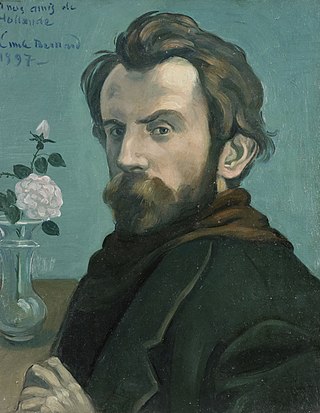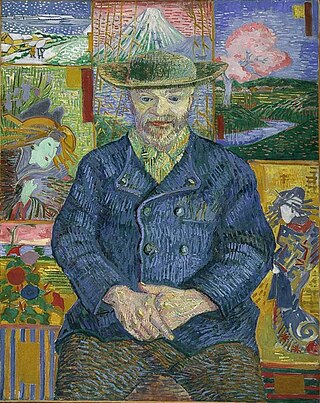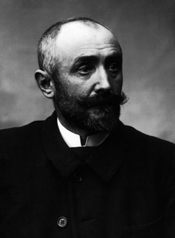
Eugène Henri Paul Gauguin was a French Post-Impressionist artist. Unappreciated until after his death, Gauguin is now recognized for his experimental use of colour and Synthetist style that were distinct from Impressionism. Toward the end of his life, he spent ten years in French Polynesia. The paintings from this time depict people or landscapes from that region.

Post-Impressionism was a predominantly French art movement that developed roughly between 1886 and 1905, from the last Impressionist exhibition to the birth of Fauvism. Post-Impressionism emerged as a reaction against Impressionists' concern for the naturalistic depiction of light and colour. Its broad emphasis on abstract qualities or symbolic content means Post-Impressionism encompasses Les Nabis, Neo-Impressionism, Symbolism, Cloisonnism, the Pont-Aven School, and Synthetism, along with some later Impressionists' work. The movement's principal artists were Paul Cézanne, Paul Gauguin, Vincent van Gogh and Georges Seurat.

Les Nabis were a group of young French artists active in Paris from 1888 until 1900, who played a large part in the transition from impressionism and academic art to abstract art, symbolism and the other early movements of modernism. The members included Pierre Bonnard, Maurice Denis, Paul Ranson, Édouard Vuillard, Ker-Xavier Roussel, Félix Vallotton, Paul Sérusier and Auguste Cazalis. Most were students at the Académie Julian in Paris in the late 1880s. The artists shared a common admiration for Paul Gauguin and Paul Cézanne and a determination to renew the art of painting, but varied greatly in their individual styles. They believed that a work of art was not a depiction of nature, but a synthesis of metaphors and symbols created by the artist. In 1900, the artists held their final exhibition and went their separate ways.

Pierre Bonnard was a French painter, illustrator and printmaker, known especially for the stylized decorative qualities of his paintings and his bold use of color. A founding member of the Post-Impressionist group of avant-garde painters Les Nabis, his early work was strongly influenced by the work of Paul Gauguin, as well as the prints of Hokusai and other Japanese artists. Bonnard was a leading figure in the transition from Impressionism to Modernism. He painted landscapes, urban scenes, portraits and intimate domestic scenes, where the backgrounds, colors and painting style usually took precedence over the subject.

Synthetism is a term used by post-Impressionist artists like Paul Gauguin, Émile Bernard and Louis Anquetin to distinguish their work from Impressionism. Earlier, Synthetism has been connected to the term Cloisonnism, and later to Symbolism. The term is derived from the French verb synthétiser.

Émile Henri Bernard was a French Post-Impressionist painter and writer, who had artistic friendships with Vincent van Gogh, Paul Gauguin and Eugène Boch, and at a later time, Paul Cézanne. Most of his notable work was accomplished at a young age, in the years 1886 through 1897. He is also associated with Cloisonnism and Synthetism, two late 19th-century art movements. Less known is Bernard's literary work, comprising plays, poetry, and art criticism as well as art historical statements that contain first-hand information on the crucial period of modern art to which Bernard had contributed.

Charles Laval was a French painter associated with the Synthetic movement and Pont-Aven School.

Fall of Leaves , or Falling Autumn Leaves is a pair of paintings by the Dutch painter Vincent van Gogh. They were executed during the two months at the end of 1888 that his artist friend Paul Gauguin spent with him at The Yellow House in Arles, France.

Pont-Aven School encompasses works of art influenced by the Breton town of Pont-Aven and its surroundings. Originally the term applied to works created in the artists' colony at Pont-Aven, which started to emerge in the 1850s and lasted until the beginning of the 20th century. Many of the artists were inspired by the works of Paul Gauguin, who spent extended periods in the area in the late 1880s and early 1890s. Their work is frequently characterised by the bold use of pure colour and their Symbolist choice of subject matter.

Vincent van Gogh made many copies of other people's work between 1887 and early 1890, which can be considered appropriation art. While at Saint-Paul asylum in Saint-Rémy-de-Provence, France, where Van Gogh admitted himself, he strived to have subjects during the cold winter months. Seeking to be reinvigorated artistically, Van Gogh did more than 30 copies of works by some of his favorite artists. About twenty-one of the works were copies after, or inspired by, Jean-François Millet. Rather than replicate, Van Gogh sought to translate the subjects and composition through his perspective, color, and technique. Spiritual meaning and emotional comfort were expressed through symbolism and color. His brother Theo van Gogh would call the pieces in the series some of his best work.

The Langlois Bridge at Arles is the subject of four oil paintings, one watercolor and four drawings by Vincent van Gogh. The works, made in 1888 when Van Gogh lived in Arles, in southern France, represent a melding of formal and creative aspects. Van Gogh used a perspective frame that he built and used in The Hague to create precise lines and angles when portraying perspective.

Portrait of Père Tanguy, painted by Vincent van Gogh in 1887, is one of his three paintings of Julien Tanguy. The three works demonstrate a progression in van Gogh's artistic style after his arrival in Paris. The first is somber, and formed from a simple composition. The second introduces van Gogh's Japanese prints. The last and most advanced in style, skill and color integrates Japanese, Impressionist, and other influences on the Parisian artist community. This painting conveys a sense of serenity that van Gogh seeks for himself. This last painting of Tanguy is in the Musée Rodin, Paris.

Agostina Segatori Sitting in the Café du Tambourin was painted by Vincent van Gogh in 1887. Agostina Segatori owned the Café du Tambourin that Van Gogh knew intimately. It was a gathering spot for Parisian artists, a place where their work was exhibited. Van Gogh, unable to pay in cash for his meals, exchanged paintings for his fare. The paintings then adorned the restaurant. He held a special exhibit of his Japanese prints in the café as well. His connection with Agostina and the cafe came to a sad end when she went bankrupt and van Gogh's paintings were confiscated by creditors. This painting, however, demonstrates an artistic discovery that culminated in his unique, creative style not quite on the brink of being understood and revered.

Almond Blossoms is a group of several paintings made in 1888 and 1890 by Vincent van Gogh in Arles and Saint-Rémy, southern France of blossoming almond trees. Flowering trees were special to van Gogh. They represented awakening and hope. He enjoyed them aesthetically and found joy in painting flowering trees. The works reflect the influence of Impressionism, Divisionism, and Japanese woodcuts. Almond Blossom was made to celebrate the birth of his nephew and namesake, son of his brother Theo and sister-in-law Jo.

Still life paintings by Vincent van Gogh (Paris) is the subject of many drawings, sketches and paintings by Vincent van Gogh in 1886 and 1887 after he moved to Montmartre in Paris from the Netherlands. While in Paris, Van Gogh transformed the subjects, color and techniques that he used in creating still life paintings.

Breton Women at a Wall is an oil painting by Émile Bernard. It is part of the permanent collection of the Indianapolis Museum of Art.

Henry Moret was a French Impressionist painter. He was one of the artists who associated with Paul Gauguin at Pont-Aven in Brittany. He is best known for his involvement in the Pont-Aven artist colony and his richly colored landscapes of coastal Brittany.

Self-Portrait with Halo and Snake, also known as Self-Portrait, is an 1889 oil-on-wood painting by French artist Paul Gauguin, which represents his late Brittany period in the fishing village of Le Pouldu in northwestern France. No longer comfortable with Pont-Aven, Gauguin moved on to Le Pouldu with his friend and student Meijer de Haan and a small group of artists. He stayed for several months in the autumn of 1889 and the summer of 1890, where the group spent their time decorating the interior of Marie Henry's inn with every major type of art work. Gauguin painted his Self-Portrait in the dining room with its companion piece, Portrait of Jacob Meyer de Haan (1889).

The Talisman is a painting by French artist Paul Sérusier made in 1888, under the guidance of Paul Gauguin at the artist's colony of Pont-Aven in Brittany. Formally known as The Bois d'Amour at Pont Aven, it was called The Talisman and became the starting point and icon of the group of young painters called The Nabis. It was a landmark in early Post-Impressionism, Synthetism, and Cloisonnism. It is now in the Musée d'Orsay in Paris.

















